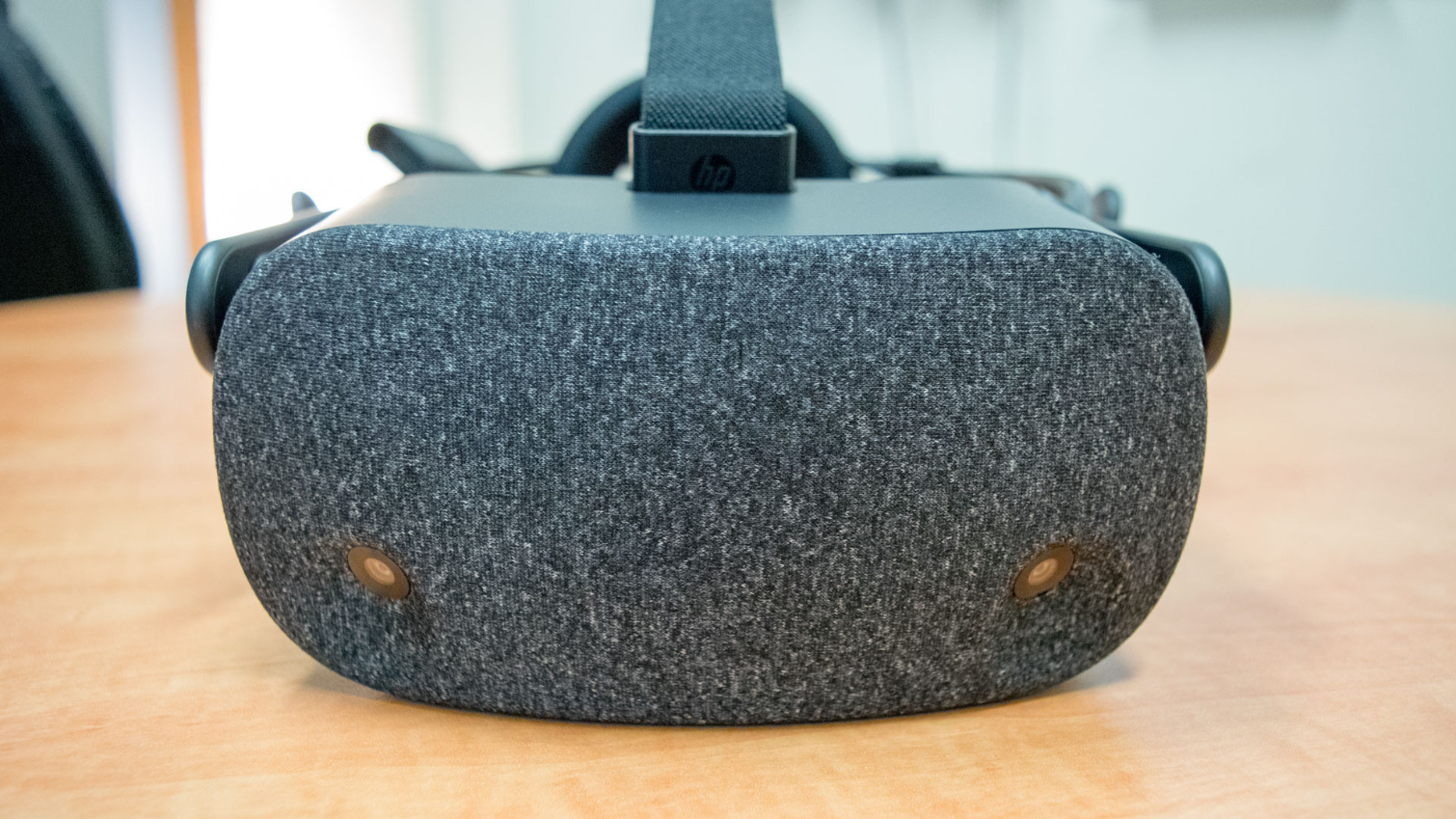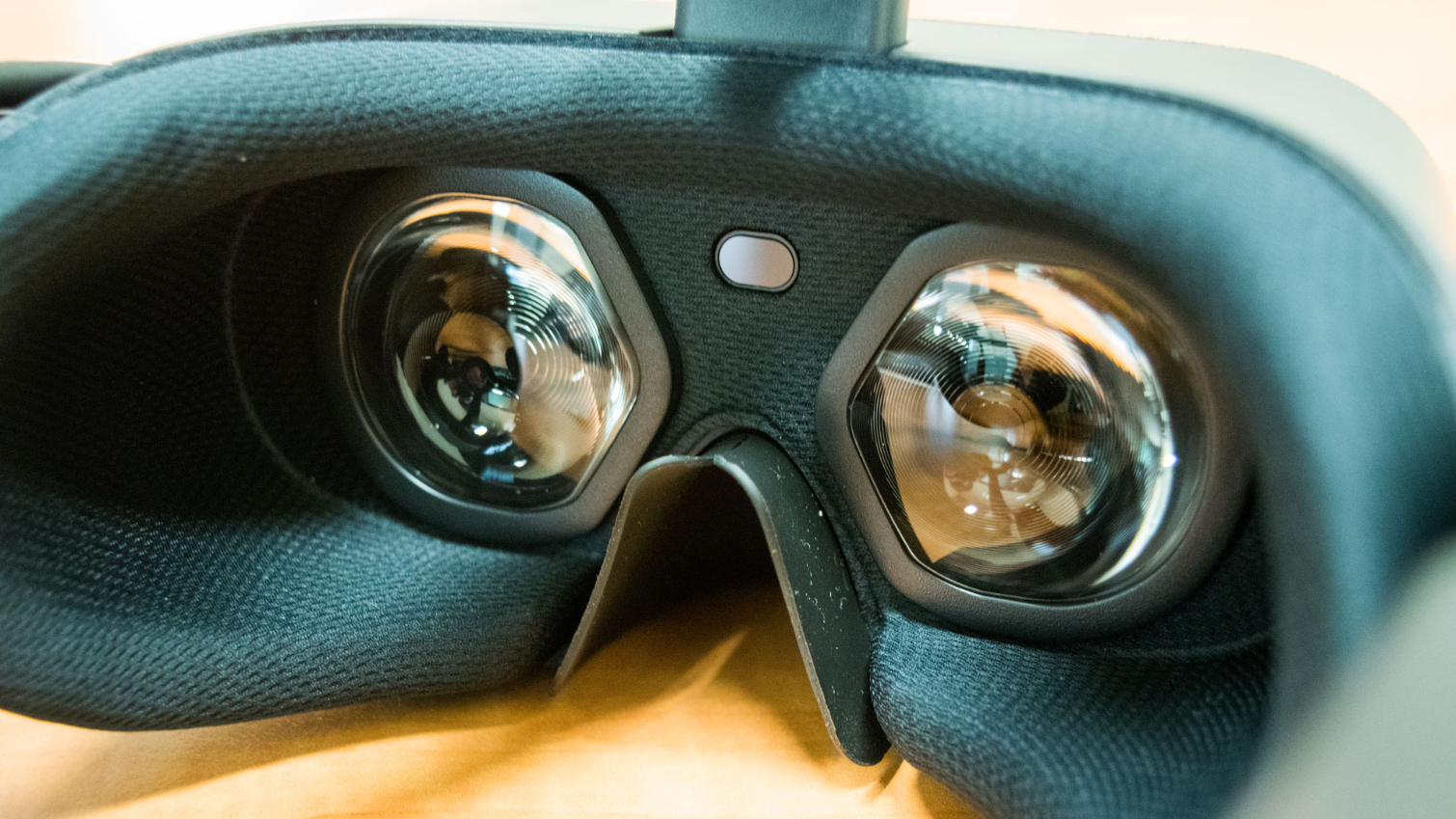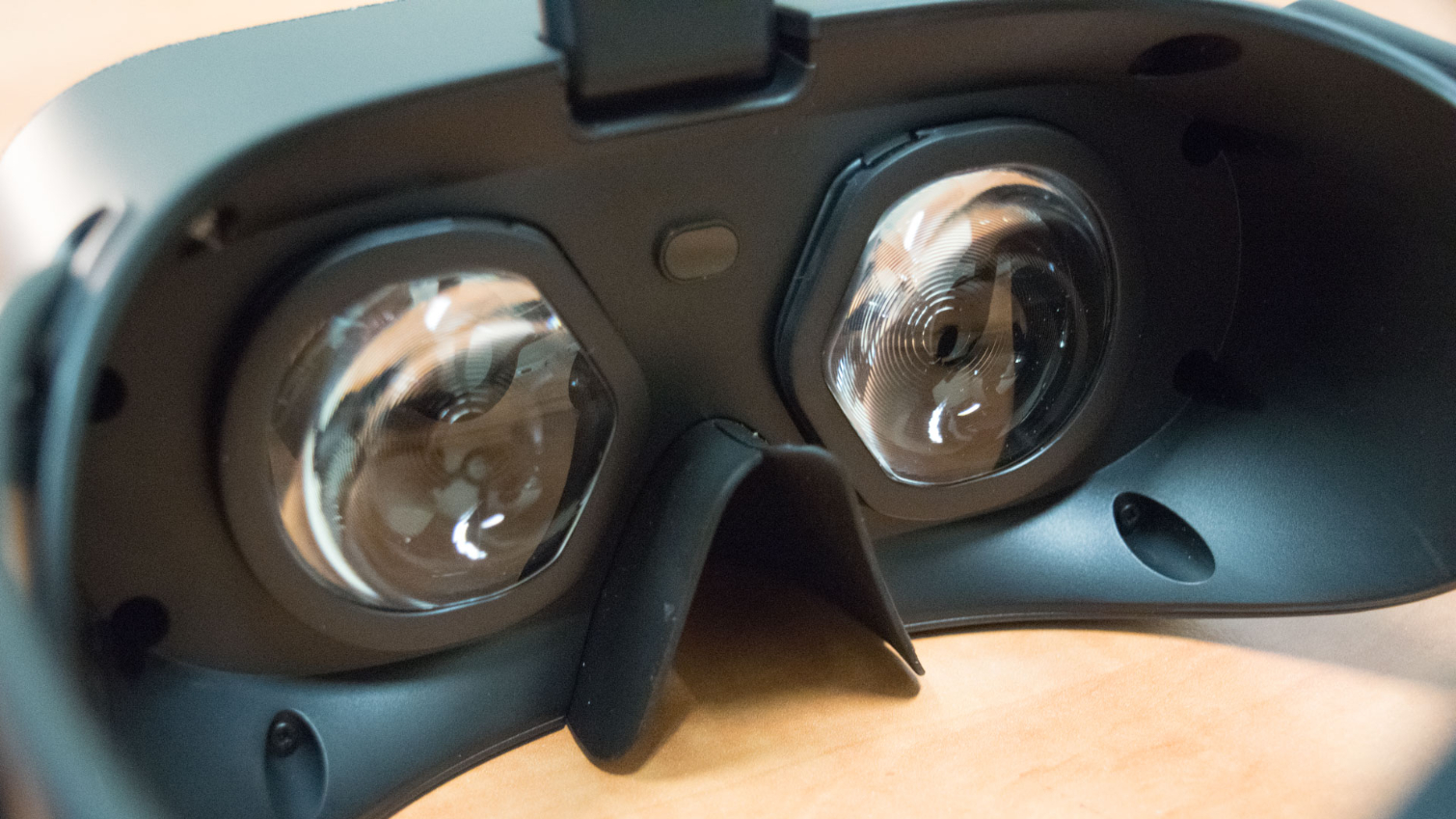Tom's Hardware Verdict
The HP Reverb headset is more comfortable than other Windows MR headsets and offers a higher resolution, but competitors offer better experiences.
Pros
- +
Exceptional visual clarity
- +
Lightweight
- +
Simple setup process
- +
Pre-paired controllers
- +
Built-in Bluetooth
Cons
- -
Poor controller ergonomics
- -
Faulty controller tracking with limited field of view
- -
No IPD adjustment
Why you can trust Tom's Hardware
HP Reverb VR Headset Review
2019 is shaping up to be a pivotal moment for the virtual reality (VR) hardware industry. All the major players are releasing new headsets that push the limits of what these devices are capable of, but it also seems like no one can decide which aspects of the VR headset design most need improvement. Some companies are going for easy to use, affordable devices. Some are pushing the boundaries with new input options and high refresh rate displays. HP is firmly in the camp that believes higher resolution is the key to the best VR headset.
I've spent the past week with the HP Reverb VR headset, and I am left somewhat conflicted. On one hand, it produces an incredible visual experience and is comfortable. However, the hand tracking is atrocious and really puts a damper on the whole experience.
HP Reverb VR Headset Specs
| Screen | Dual 2.89-inch LCD panels with Pulse Backlight technology |
| Resolution | 2160 x 2160 per eye (4320 x 2160 combined) |
| Subpixel Rendering | RGB sub-pixels |
| Refresh Rate | 90 Hz with recommended system specs |
| Field of View | ~114-degrees, Fresnel-Aspherical |
| Tracking | 2x front-facing cameras |
| Sensors | Windows Mixed Reality inside/out, 6-DOF motion tracking, gyroscope, accelerometer, magnetometer |
| Eye adjustments | 63mm +/- 8mm by software control |
| Connections | DisplayPort 1.3, USB 3.0, stereo 3.5 mm headphone/mic jack |
| Cables | 3.5m 2-in-1 (DisplayPort 1.3 and USB 3.0) cableFull-size DisplayPort to mini DisplayPort adapter |
| Face Cushion | Replaceable, cloth-covered foam |
| Dimensions (without straps) | 2.17 x 6.97 x 3.31 inches / 55 x 177 x 84mm |
| Weight (without cable) | 1.1 pounds / 498g |
| Price | $599 (consumer version) |
Elegant Design
At first glance, HP's Reverb headset is a very nice-looking device with a sleek exterior made of smooth black plastic contrasted with dark gray fabric material on the front and rear of the headset. It features a 3-point head strap that resembles the one found on the original Oculus Rift. The side straps are mounted to the headset with a rigid plastic structure that includes a hinge to let you the rotate the position of the straps.
Above the left hinge is a cut-out for the tether cable and audio jack lead. Like HP's first Windows Mixed Reality (MR) headset, the Reverb features a detachable tether cable. Unlike its predecessor, the Reverb's cable attachment includes a latch to secure it in place. The new cable is a different shape, so you can't use the cable from the old HP headset on the new device or vice versa.
DisplayPort Interface
The first-generation Windows MR headsets used HDMI cables, but the resolution of the Reverb exceeds the specifications of the HDMI ports found on most graphics cards, so it has a DisplayPort interface.
HP also includes a DisplayPort to mini DisplayPort adapter with the Reverb headset, which is a nice touch for laptop owners. Although, you would need a powerful laptop, as the minimum specifications for the Reverb are a significant step beyond most headsets. You need a computer with at least a GTX 1080 or RX Vega 64 graphics card to power the headset.
Ultra-High Resolution, Wider and Shorter FOV
The graphics card requirements for the Reverb headset are so high because the Reverb offers a much higher resolution than almost any VR headset on the consumer market. The Reverb features dual 2.89-inch LCDs, each with 2160 x 2160 resolution, which is a significant increase from the 1440 x 1600 panels featured in the HTC Vive Pro, Samsung HMD Odyssey and upcoming Valve Index.
Get Tom's Hardware's best news and in-depth reviews, straight to your inbox.
And it's a massive jump from first-gen VR headsets, like the Rift and HTC Vive, which offer 1080 x 1200 per eye resolution. Incredibly, the combined horizontal resolution of the first-gen headsets is equal to the per-eye resolution of HP's Reverb. The Reverb's combined horizontal resolution is a staggering 4,320 pixels, which is more than that of a 4K display (3840 pixels).
HP likes to highlight that the Reverb headset produces a broader field of view (FOV) than competing headsets. I didn’t notice the difference when I first donned the Reverb, but when I jumped from the Reverb to the Vive Pro for the benchmark tests, the extra few degrees of vision were much more evident. It is by no means a game changer, but the wider view is a welcomed touch.
HP used square displays instead of inverted rectangular displays, which results in a reduction in vertical FOV compared to most headsets. I would love to tell you that the display height doesn't make a difference, but it did impact the experience. My view into the virtual world was cut off below my nose, which triggered a strange sensation that reduced my level of immersion while gaming. It almost looked like I was wearing a breathing mask over my mouth and nose. To someone new to VR, however, this would probably wouldn't be so apparent.
Impressive Image Clarity
HP's Reverb produces excellent image quality. I've never been able to read text so clearly in VR before. I first noticed just how clear and crisp the display was when I launched Serious Sam VR: The Last Hope and saw how well I could read the menus.
With the Rift and the Vive, the menus in Serious Sam VR are legible but noticeably blurry with prominent godray distortion, which is only mildly improved in the Vive Pro. With the Reverb, godrays weren't a problem, and the edges of each character on the menu were sharp.
I didn't catch a glimpse of screen door effect. The Reverb's LCD panels are not only high-resolution but also feature full RGB sub-pixel arrays, like the Sony PSVR, to help produce lifelike colors. The LCD panel also uses a stripe array, which means the sub-pixels are aligned in rows rather than the checkerboard pattern of PenTile displays found in OLED headsets, like the Rift and Vive Pro .
Acceptable Black Levels
A lot of people complain about LCD panels used in head-mounted displays (HMDs) because they can't produce the same vivid black levels that AMOLED panels can. However, low-persistence and RGB sub-pixels do far more to improve the VR experience than deeper blacks ever could.
The Reverb's display panels include Pulse Backlight technology, which is supposed to improve the LCD panels' black levels. I don’t know how much difference the Pulse Backlight actually makes, but I can tell you the black levels in the Reverb compare very well to the Vive Pro’s AMOLED display.
Copycat Head Strap Design
It looks like HP tried to replicate the springy mechanism of the Rift's side straps, which allows you to pull the headset off without loosening the Velcro that holds it secure. Unfortunately, the springs are shorter than I would like. I ended up setting the straps looser than I preferred so that I could slip it off without undoing the strap.


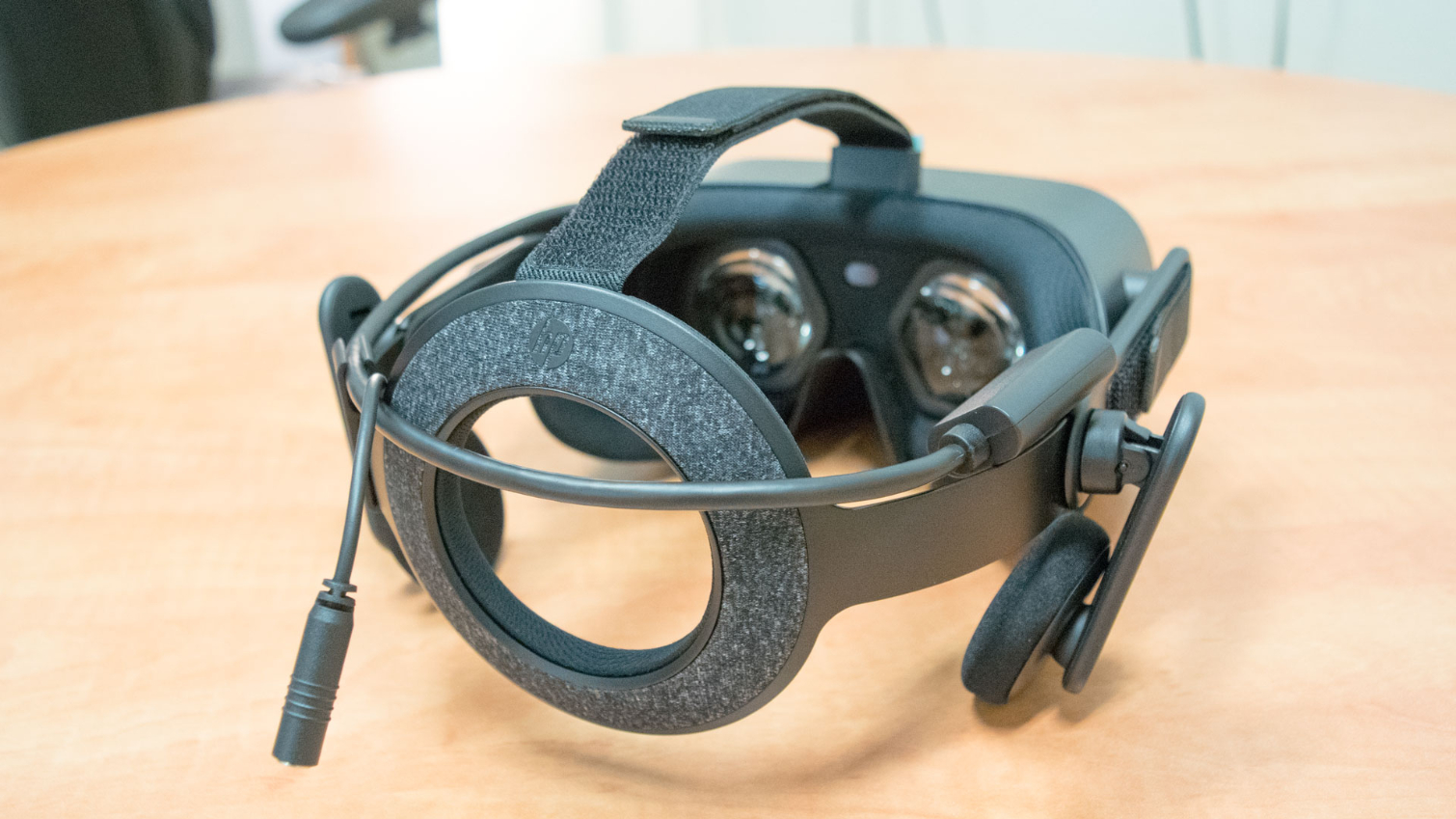
The top strap is a thin Velcro strip made of a rigid material, like a tie strap you would find on camping equipment. It attaches to the visor with a plastic bracket that makes it difficult to adjust the length of the top strap.
No Flip Visor
Curiously, HP deleted one of the best features from its first Windows MR headset. The Reverb doesn't include a flip visor, which means you need to take it off your head if you want to grab a sip of your drink or talk to someone who just walked into the room.
You can flip it up slightly, but not enough to clear the proximity sensor that tells the MR Portal to give you mouse and keyboard access on the desktop.
Removable Face Cushion
The consumer version of the Reverb comes with a washable fabric face cushion. It's soft and breathable but still seems like it will absorb sweat like a sponge. The professional version of the headset has a washable leather face cushion, a superior option that I think everyone should've received.
The fabric cushion attaches to the headset with a pair of Velcro tabs, and the fabric slips under a lip on each lens in a similar fashion to the Oculus Go headset. It's easy to remove the cushion if you need to replace it. Hopefully, HP will make alternative accessories available in the future.
Cheap Feeling Headphones
The Reverb's head strap is an upgrade compared to most of the Windows MR headsets, but integrated audio is arguably more important. In the first generation, Samsung was the only Windows MR partner vendor that included headphones with its headset. This time around, HP bundled everything into one package. But the headphones on the Reverb headset aren't going to win any awards.
They produce excellent clean audio but feel inferior. The adjustment hinges are flimsy and seem like they won't stand the test of time. One of the hinges on my review unit is already wearing out. The left speaker makes a loud snap when I pull it away from my ear, but the right hinge barely makes any noise and feels like the locking mechanism is already loose. I suspect that the tab that holds the headphones in the open position will wear out sooner than later.
Nevertheless, the integrated headphones are a wonderful addition, simply thanks to the convenience of not needing multiple devices to enjoy VR. They're removable, and the headset also includes a 3.5mm jack, in case you wish to use a better pair of headphones.
Hello, Cortana
The Reverb includes two built-in microphones to enable voice recognition for use with Cortana right out of the box. There's a lot to be said about having every necessary component in a single package.
Speaking of which, the Reverb also includes a feature that should have been part of every Windows MR headset.
No More Bluetooth Dongles
Microsoft's Windows MR controllers must be paired to your computer via Bluetooth, which is probably my biggest pet peeve about the first-generation MR headsets. It wouldn't cost much to include a Bluetooth radio—even a USB dongle—with the headset bundle, but none of the MR vendors bothered to do that. HP, however, must have picked up on the complaints because this time around the company included a built-in Bluetooth receiver.
Strangely, when I was pairing the headset with my PC, Microsoft's scan process said that my computer didn't include a Bluetooth radio. Fortunately, the controllers connected anyway. And to my surprise, the controllers came out of the box pre-paired to the headset. My computer detected them as soon as I powered them on.
Not These Wands Again!
It's clear to see that HP put effort into building the Reverb headset, and the result is unquestionably the best MR headset available today. Unfortunately, that doesn't matter because HP's neglected to update the controllers, and these controllers honestly ruin the entire experience. I'm more than a little bit disappointed.
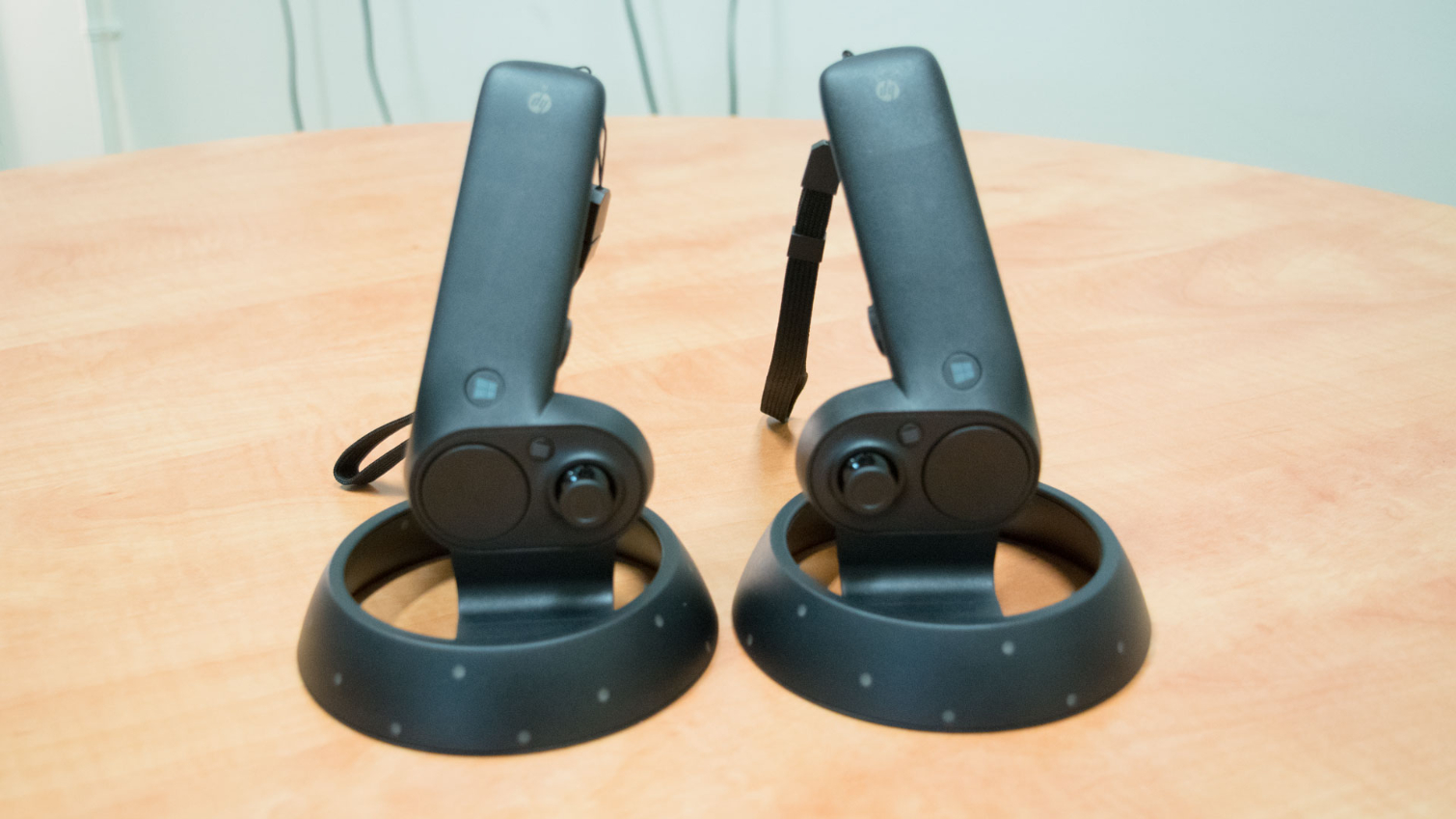

Last year, I complained about Microsoft's terrible, unergonomic, flimsy controllers. I couldn't believe that all the MR partners, save for Samsung, used Microsoft's reference design. As a first-generation design, they weren't the worst thing in the world, but they weren't good either. Now, a year and a half later, HP continues to use the original controller design, and that's just bad.
Put bluntly: these controllers aren't acceptable in today's VR market. Even just a few subtle changes (like the ones Samsung made) could have made a significant difference.
MORE: Best Virtual Reality Headsets
MORE: All Virtual Reality Content
MORE: Virtual Reality Basics
Kevin Carbotte is a contributing writer for Tom's Hardware who primarily covers VR and AR hardware. He has been writing for us for more than four years.
-
1trillion Replykcarbotte said:HP Reverb is the best Windows Mixed Reality headset, but that may be its biggest downfall. It's impressive, but the included controllers ruin the experience.
HP Reverb VR Headset Review: Windows Mixed Reality Never Looked So Good : Read more
kcarbotte said:HP Reverb is the best Windows Mixed Reality headset, but that may be its biggest downfall. It's impressive, but the included controllers ruin the experience.
HP Reverb VR Headset Review: Windows Mixed Reality Never Looked So Good : Read more
I am so frustrated with all the reviews putting down the controllers yet NOT ONE of the Reviews EVER indicates that one could just use the HTC Vive Light house controllers instead of the WMR controllers if the user really wanted better controller accuracy.
It is a super simple fix. Just look on YouTube for simple instructions on how to utilize the Light House controller from the HTC Vive.. (Yes I know it is more expensive to go that route but holy cow people... If the crap controllers from the default WMR equipment bothers you that much then bite the bullet and spend a little more and figure out how to engage the light house controllers from the HTC Vive .... It's super easy to do... and stop your complaining.. )
If you are already into VR that much that you've purchased the high end GPU and CPU combo with a high end VR headset with good resolution then purchasing or 'Using' the light house units from perhaps your previously purchased HTC Vibe should be worth your time and effort (and extra expense if you have to go and purchase them separately )... You've already done 95 percent of the work getting all the other gear setup for a great VR experience why would you stop 'there' and just deal with the crappy WMR controllers.... JUST go the final distance and set up the HTC Vibe light house tracking units with their controllers and have the best of both worlds (great resolution AND great tracking).... ---- Simple enough..... -
cryoburner Reply
You mean "microphones"?kcarbotte said:The Reverb includes two built-in headphones to enable voice recognition for use with Cortana right out of the box.
People shouldn't be expected to use alternate controllers. And of course, adding Vive controllers also means buying and setting up lighthouses, which defeats much of the point of the WMR headsets having self-contained tracking.1trillion said:I am so frustrated with all the reviews putting down the controllers yet NOT ONE of the Reviews EVER indicates that one could just use the HTC Vive Light house controllers instead of the WMR controllers if the user really wanted better controller accuracy.
And in terms of cost, adding a pair of Vive controllers and two lighthouses adds over $500 to the setup, or around $600 if you want the new Index controllers, effectively doubling the cost of the headset. Spending $600 just to get a decent pair of controllers does not seem practical. Likewise it shouldn't be expected that people will already have such equipment on-hand. The majority of existing VR users have headsets that don't use lighthouses, and a lot of the people buying one of these will be first-time VR users, considering how small the existing VR user-base is.
And why shouldn't reviews complain about it? Complaints are likely to lead to the hardware getting improved in future devices, so they should be in your best interest. -
1trillion Replycryoburner said:You mean "microphones"?
People shouldn't be expected to use alternate controllers. And of course, adding Vive controllers also means buying and setting up lighthouses, which defeats much of the point of the WMR headsets having self-contained tracking.
And in terms of cost, adding a pair of Vive controllers and two lighthouses adds over $500 to the setup, or around $600 if you want the new Index controllers, effectively doubling the cost of the headset. Spending $600 just to get a decent pair of controllers does not seem practical. Likewise it shouldn't be expected that people will already have such equipment on-hand. The majority of existing VR users have headsets that don't use lighthouses, and a lot of the people buying one of these will be first-time VR users, considering how small the existing VR user-base is.
And why shouldn't reviews complain about it? Complaints are likely to lead to the hardware getting improved in future devices, so they should be in your best interest.
Complain about it is ok but at least show there is a possible workaround the problem for those who are willing to go the extra step because many people do not know there IS A workaround solution.... -
techguy2 Thank for review and after reading it I am even more looking forward to buying this headset. I do have a few points I disagree with:Reply
"No Flip Visor... HP deleted one of the best features from its first Windows MR headset... You can flip it up slightly, but not enough to clear the proximity sensor that tells the MR Portal to give you mouse and keyboard access on the desktop."
I disagree as this was the first thing that breaks for many people, to they just made more durable headset. In addition it did not work as expected. As a VR apps developer, it should have helped me be able to flip the visor up and see my monitor, but no, I still have to lift my head 45 degrees to see the screen, so even though it is easier than removing the headset completely, unless I have to change just a small thing, it puts too much strain on my neck. With Flashlight features, I can still find my coffee cup without removing the visor.
Proximity sensor capturing cursor was also badly implemented, that at the end I placed piece of masking tape on the sensor so the headset would not constantly turn on, or hijack my mouse/keyboard. This way I can manually switch with win+y to the input mode I need. -
mbaranDET I'm confused, the article states you need an RX VEGA 64 to power the headset? Does this mean for gaming? For non gaming uses, could you use a lower graphics card to power? Would a RX580 power the headset to use in Virtual Desktop/Virtual Cinema? Not to game just to view high 4k movies and large file VR movies? ThanksReply -
cryoburner I suspect they're referring to the hardware that will be needed to run most games well at the headset's native resolution. Some software will undoubtedly be less demanding, and could get away with less powerful graphics hardware.Reply
Once people have the headset, I'm sure we'll hear more about how a wider selection of software performs at its native resolution on various graphics cards. From what I've heard though, the headset missed its planned release date, and still isn't available for sale. -
techguy2 Reply
You need display port 1.3 or 1.4 to be able to push all those pixels at 90Hz refresh rate, but on lower end GPUs that do support that DP1.3 you may not be able to run something like fallout 4 VR but is should be enough for movies and some less intensitive gamesmbaranDET said:I'm confused, the article states you need an RX VEGA 64 to power the headset? Does this mean for gaming? For non gaming uses, could you use a lower graphics card to power? Would a RX580 power the headset to use in Virtual Desktop/Virtual Cinema? Not to game just to view high 4k movies and large file VR movies? Thanks
